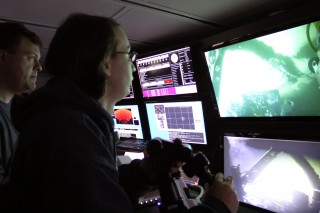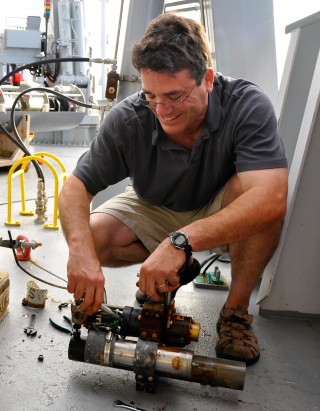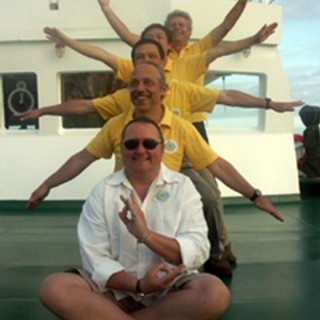One of my NSF program managers sent me a message today saying that our live broadcasts could do with better music.

Unfortunately, Jeremy (ETO and Higher Life Form) found out the hard way earlier in the cruise, when testing out the system, that we cannot lay music over the web-cast on YouTube due to Piracy Laws. Which re-opens a long-term debate of who we more closely resemble: Johnny Depp of Bill Nighy (If, like Mike-at-Midnight Cheadle, you have never seen the movie “Pirate Radio”, please disconnect now – there’s no hope).
But for those still reading, my tune of the day for today is most surely Bob Marley’s. Let me explain.
In 2009, we came to the Mid-Cayman Rise onNereus’ first funded science project, right after it had completed its proving cruise, a few months earlier, diving to the floor of Challenger Deep in the Mariana Trench – the same place that James Cameron returned to in his Deep Sea Challenger vehicle last year. On our first dive, as we approached the seafloor – with a National Geographic TV team on board filming every moment – we had a nasty surprise. We rather plummeted into a thankfully soft and sediment-covered patch of seafloor and found ourselves almost anchored to the spot. After an hour of working our way across the seafloor on that dive we realized that we had no option but to jettison an item of science gear or else we might never get Nereus back aboard ship and, unfortunately for Jeff, he had the only equipment on board the vehicle that was heavy enough to gain us the extra buoyancy required. So way back then we made sure we had the best possible navigation information possible and then placed the bottle carefully on the seabed, never to return – until today.
Fast forward 4 years.

Today we dived with a light and relatively empty basket and a cunning plan. Knowing that we were diving later than ideal but had to leave the seafloor at 2pm we had a two-part strategy: dive straight to a low temperature hydrothermal site that is of particular interest for Jill’s thesis work and Julie’s microbial studies (also of interest to Jill’s Mum who was paying attention faster than Jill, this morning!) and then, as soon as we had an initial set of samples, or as soon as midday came around (whichever came first) we would break off and drive off into the dark to look for the missing IGT bottle.
So how did we make that work?
Basically, we pulled on multiple different facets of the Nereus team. From one direction, James and Jon spent long hours during the second half of yesterday and through into the late morning today working through as many possible aspects of understanding our navigation data and looking through all the video data that I am most familiar with from this year, from our dives in 2012 and also our work in 2009 (I have copies of all those video files here with me). This helped in two ways. First, by midnight last night, Jon and James had reconciled all of the navigation data from 2012 with yesterday’s “driving around in the dark, wondering why the map was wrong” dive experience and explaining it by allowing for there to be an ~15m offset between “reality” and this year’s USBL navigation. By convincing ourselves that this made sense, we tested that at the very start of the dive by using the same correction to guide us to where our target “Hot Chimlets” site should be. James & Jon’s calculations worked perfectly: we arrived on the seafloor at 9;24 we saw the seafloor for the first time. At 9:27 I recognized where we were and it was exactly where I had wanted us to be. As Leighton’s 9:28 entry in our dive log recorded it so aptly: “Chris is very happy”. Darn tootin’!
Leaving Jeff, Sean and Jill, and then Julie, Julie & Chip to do their sampling, it was soon time to reconvene with James and Jon in the mess and strategize further: if we now understood our 2012 and 2013 navigation this well, could we then develop a strategy that merged our 2009 information as well to come up with a search strategy to find Jeff’s sampler. Using James’ cerebral approach based on the navigation data and extensive notes he took in 2009 together with some more grunt-work capabilities that I could offer based on looking at the 2009 videos over the past few days and knowing what just looks right/familiar we came up with a plan: drive off into the dark for about 500m high across the rift valley floor until we flew into the far eastern wall, approaching it from the same direction as we did in 2009 and at the same depth.
As soon as midday came around, that’s what we did. Since we had 100% battery charge at the start of the day and we only had 5h to use it, we even set a new speed record for Nereus in ROV mode during that transect and reached the far wall in under half an hour. From there the method was simple – we worked our way down the edge of the cliff face, at the appropriate depth, until we found a dip in the top of the cliff face so that we could move forward onto a flat “cliff-top”. We then continued further south until the edge of the cliff rose up again and we knew the full width of the space in which our sampler must have been left behind in 2009. Then, all we had to do was work back north onto that terrace and start progressing west until we found it. The strategy worked – by 12:30 we had made the transit and started out search and by 1:30 we had found the bottle on the seafloor. Very aptly, it was Jeff who spotted his beloved Bottle #5 first. Even more aptly, it was Bottle #6 that was in the basket with Bottle #5 on Oct 31st, 2009 – and it was Bottle #6 that was in the basket again today when Bottle #5 was found. We did also have Bottle #4 in the basket too so, in the days ahead, I suspect Bottle #6 will have some explaining to do…
But I digress…
1:30pm, we had found the bottle but had not yet picked it up. 30 minutes to go. Last night, after we had agreed that the strategy for today was to include searching for Jeff’s sampler, some friendly rivalry and banter had been exchanged between our two Nereus pilots on this cruise, Chris and Casey. Both had been on our dives in 2009 (so too, James, Andy and Jon from the Nereus team plus me, Jeff, Jill, Sean, Julie H., Max and Cindy from the science team) and Casey had insisted that it was to be him sitting in the pilot’s chair and picking the bottle up as and when we found it, while Chris had been teasing that we would leave Casey asleep and he would make the rescue. In the end, both were right. As we approached the bottle, and the noise and excitement rose among the scientists, Casey noted that huge amounts of sediment were being blown up around the vehicle and that he was going to need all the help he could get to make the dive end in success. Calling Chris to the van, Casey handed over controls for Nereus to Chris while he took care of the manipulator. My only contribution was to call for silence from everyone else who wanted to stay and watch so that Casey and Chris could hear what each other were doing and 15 minutes later, working in perfect partnership, the two of them had landed the sampler safely back in Nereus’ basket at a location pretty much right where James’ efforts had said it should be. What a team ☺
On the Nereus team’s collective behalf I feel suitably righteous tonight. I don’t understand half of what they do to make Nereus work, but I know I like it when they do. As Arthur C Clarke once wrote: when primitive humans meet advanced alien cultures, their technologies will be indistinguishable from magic. Welcome to my life hanging out with WHOI’s deep submergence lab!
Just to end the day, Leighton then took us one step further and showed that we now REALLY understand the navigation of the Piccard site. Using his navigational fixes, acquired during the course of yesterday’s dive, Nathan and I are just wrapping up a CTD cast with Max that has collected him ~250 liters of warm soupy water from right over the Piccard vents. I’m afraid I am not staying up to see the cast end – I am getting back up in 5 hours’ time for the start of the next Nereus dive – but I think in Max’s mind, tonight’s site will forever be branded as Leighton’s Smack-Down.
Off to Von Damm tomorrow – come for the tube worms, stay for the mussels?

